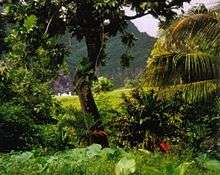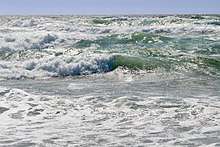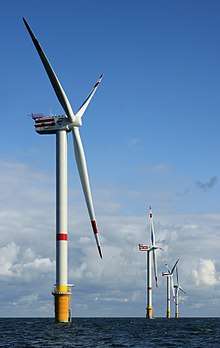Natural resource



Natural resources are resources that exist without actions of humankind. This includes all valued characteristics such as magnetic, gravitational, electrical properties and forces etc. On earth it includes: sunlight, atmosphere, water, land (includes all minerals) along with all vegetation, crops and animal life that naturally subsists upon or within the heretofore identified characteristics and substances.[1][2][3][4]
Particular areas such as the rainforest in Fatu-Hiva are often characterized by the biodiversity and geodiversity existent in their ecosystems. Natural resources may be further classified in different ways. Natural resources are materials and components (something that can be used) that can be found within the environment. Every man-made product is composed of natural resources (at its fundamental level). A natural resource may exist as a separate entity such as fresh water, air, and as well as a living organism such as a fish, or it may exist in an alternate form that must be processed to obtain the resource such as metal ores, rare earth metals, petroleum, and most forms of energy.
There is much debate worldwide over natural resource allocations, this is particularly true during periods of increasing scarcity and shortages (depletion and overconsumption of resources) but also because the exportation of natural resources is the basis .
Classification
There are various methods of categorizing natural resources, these include source of origin, stage of development, and by their renewability.
On the basis of origin, natural resources may be divided into two types:
- Biotic — Biotic resources are obtained from the biosphere (living and organic material), such as forests and animals, and the materials that can be obtained from them. Fossil fuels such as coal and petroleum are also included in this category because they are formed from decayed organic matter.
- Abiotic – Abiotic resources are those that come from non-living, non-organic material. Examples of abiotic resources include land, fresh water, air, rare earth metals and heavy metals including ores such as gold, iron, copper, silver, etc.
Considering their stage of development, natural resources may be referred to in the following ways:
- Potential resources — Potential resources are those that may be used in the future—for example, petroleum in sedimentary rocks that, until drilled out and put to use remains a potential resource
- Actual resources — Those resources that have been surveyed, quantified and qualified and, are currently used—development, such as wood processing, depends on technology and cost
- Reserve resources — The part of an actual resource that can be developed profitably in the future
- Stock resources — Those that have been surveyed, but cannot be used due to lack of technology—for example, hydrogen
Many natural resources can be categorized as either renewable or non-renewable:
- Renewable resources — Renewable resources can be replenished naturally. Some of these resources, like sunlight, air, wind, water, etc., are continuously available and their quantity is not noticeably affected by human consumption. Though many renewable resources do not have such a rapid recovery rate, these resources are susceptible to depletion by over-use. Resources from a human use perspective are classified as renewable so long as the rate of replenishment/recovery exceeds that of the rate of consumption. They replenish easily compared to Non-renewable resources.
- Non-renewable resources – Non-renewable resources either form slowly or do not naturally form in the environment. Minerals are the most common resource included in this category. By the human perspective, resources are non-renewable when their rate of consumption exceeds the rate of replenishment/recovery; a good example of this are fossil fuels, which are in this category because their rate of formation is extremely slow (potentially millions of years), meaning they are considered non-renewable. Some resources actually naturally deplete in amount without human interference, the most notable of these being radio-active elements such as uranium, which naturally decay into heavy metals. Of these, the metallic minerals can be re-used by recycling them,[5] but coal and petroleum cannot be recycled.[6] Once they are completely used they take millions of years to replenish.
Extraction
Resource extraction involves any activity that withdraws resources from nature. This can range in scale from the traditional use of preindustrial societies, to global industry. Extractive industries are, along with agriculture, the basis of the primary sector of the economy. Extraction produces raw material, which is then processed to add value. Examples of extractive industries are hunting, trapping, mining, oil and gas drilling, and forestry. Natural resources can add substantial amounts to a country's wealth,[7] however a sudden inflow of money caused by a resource boom can create social problems including inflation harming other industries ("Dutch disease") and corruption, leading to inequality and underdevelopment, this is known as the "resource curse".
Extractive industries represent a large growing activity in many less-developed countries but the wealth generated does not always lead to sustainable and inclusive growth. People often accuse extractive industry businesses as acting only to maximize short-term value, implying that less-developed countries are vulnerable to powerful corporations. Alternatively, host governments are often assumed to be only maximizing immediate revenue. Researchers argue there are areas of common interest where development goals and business cross. These present opportunities for international governmental agencies to engage with the private sector and host governments through revenue management and expenditure accountability, infrastructure development, employment creation, skills and enterprise development and impacts on children, especially girls and women.[8] A strong civil society can play an important role in ensuring effective management of natural resources. Norway can serve as a role model in this regard as it has good institutions and open and dynamic public debate with strong civil society actors that provide an effective checks and balances system for government's management of extractive industries.[9]
Depletion of resources

In recent years, the depletion of natural resources has become a major focus of governments and organizations such as the United Nations (UN). This is evident in the UN's Agenda 21 Section Two, which outlines the necessary steps for countries to take to sustain their natural resources.[10] The depletion of natural resources is considered a sustainable development issue.[11] The term sustainable development has many interpretations, most notably the Brundtland Commission's 'to ensure that it meets the needs of the present without compromising the ability of future generations to meet their own needs',[12] however in broad terms it is balancing the needs of the planet's people and species now and in the future.[10] In regards to natural resources, depletion is of concern for sustainable development as it has the ability to degrade current environments[13] and potential to impact the needs of future generations.[11]
Depletion of natural resources is associated with social inequity. Considering most biodiversity are located in developing countries,[15] depletion of this resource could result in losses of ecosystem services for these countries.[16] Some view this depletion as a major source of social unrest and conflicts in developing nations.[17]
At present, with it being the year of the forest,[18] there is particular concern for rainforest regions that hold most of the Earth's biodiversity.[18] According to Nelson[19] deforestation and degradation affect 8.5% of the world's forests with 30% of the Earth's surface already cropped. If we consider that 80% of people rely on medicines obtained from plants and ¾ of the world's prescription medicines have ingredients taken from plants,[16] loss of the world's rainforests could result in a loss of finding more potential life saving medicines.[20]
The depletion of natural resources is caused by 'direct drivers of change'[19] such as Mining, petroleum extraction, fishing and forestry as well as 'indirect drivers of change' such as demography, economy, society, politics and technology.[19] The current practice of Agriculture is another factor causing depletion of natural resources. For example, the depletion of nutrients in the soil due to excessive use of nitrogen[19] and desertification.[10] The depletion of natural resources is a continuing concern for society. This is seen in the cited quote given by Theodore Roosevelt, a well-known conservationist and former United States president, who was opposed to unregulated natural resource extraction.
Protection
In 1982, the UN developed the World Charter for Nature, which recognized the need to protect nature from further depletion due to human activity. It states that measures must be taken at all societal levels, from international to individual, to protect nature. It outlines the need for sustainable use of natural resources and suggests that the protection of resources should be incorporated into national and international systems of law.[21] To look at the importance of protecting natural resources further, the World Ethic of Sustainability, developed by the IUCN, WWF and the UNEP in 1990,[22] set out eight values for sustainability, including the need to protect natural resources from depletion. Since the development of these documents, many measures have been taken to protect natural resources including establishment of the scientific field and practice of conservation biology and habitat conservation, respectively.
Conservation biology is the scientific study of the nature and status of Earth's biodiversity with the aim of protecting species, their habitats, and ecosystems from excessive rates of extinction.[23][24] It is an interdisciplinary subject drawing on science, economics and the practice of natural resource management.[25][26][27][28] The term conservation biology was introduced as the title of a conference held at the University of California, San Diego, in La Jolla, California, in 1978, organized by biologists Bruce A. Wilcox and Michael E. Soulé.
Habitat conservation is a land management practice that seeks to conserve, protect and restore, habitat areas for wild plants and animals, especially conservation reliant species, and prevent their extinction, fragmentation or reduction in range.[29]
Management
Natural resource management is a discipline in the management of natural resources such as land, water, soil, plants, and animals—with a particular focus on how management affects quality of life for present and future generations. Hence, sustainable development is followed according to judicial use of resources to supply both the present generation and future generations.
Management of natural resources involves identifying who has the right to use the resources and who does not for defining the boundaries of the resource.[30] The resources are managed by the users according to the rules governing of when and how the resource is used depending on local condition.[31]
A "...successful management of natural resources depends on freedom of speech, a dynamic and wide-ranging public debate through multiple independent media channels and an active civil society engaged in natural resource issues...",[32] because of the nature of the shared resources the individuals who are affected by the rules can participate in setting or changing them.[30] The users have rights to devise their own management institutions and plans under the recognition by the government. The right to resources includes land, water, fisheries and pastoral rights.[31] The users or parties accountable to the users have to actively monitor and ensure the utilisation of the resource compliance with the rules and to impose penalty on those peoples who violates the rules.[30] These conflicts are resolved in a quick and low cost manner by the local institution according to the seriousness and context of the offence.[31] The global science-based platform to discuss natural resources management is the World Resources Forum, based in Switzerland.
Natural Resources by country
| Value of Natural Resources by country (in USD Trillions), 2016[33] | ||
|---|---|---|
| Country | Value | |
| 75 | ||
| 45 | ||
| 34.4 | ||
| 33.2 | ||
| 27.3 | ||
| 23 | ||
| 21.8 | ||
| 19.9 | ||
| 15.9 | ||
| 14.35 | ||
See also
References
- ↑ "natural resources - definition of natural resources in English". Oxford Dictionaries. 2014-04-20. Retrieved 2016-12-12.
- ↑ "Definition of natural resource - Student Dictionary". Wordcentral.com. 2012-09-20. Retrieved 2016-12-12.
- ↑ "What is Natural Resources? definition and meaning". Investorwords.com. Retrieved 2016-12-12.
- ↑ "Natural resource dictionary definition | natural resource defined". Yourdictionary.com. Retrieved 2016-12-12.
- ↑ "Earth's natural wealth: an audit". Science.org.au. May 23, 2007. Archived from the original on July 20, 2008.
- ↑ "Peak Everything?". Reason.com. April 27, 2010.
- ↑ "EnviroStats: Canada's natural resource wealth at a glance". Statcan.gc.ca. Retrieved 2014-05-31.
- ↑ Evelyn Dietsche; Samantha Dodd; Dan Haglund; Mark Henstridge; Maja Jakobsen; Esméralda Sindou; Caroline Slaven. "Extractive industries, development and the role of donors - ECONOMIC AND PRIVATE SECTOR PROFESSIONAL EVIDENCE AND APPLIED KNOWLEDGE SERVICES". Partberplatform.org. Retrieved 2016-12-12.
- ↑ Indra Overland (2018) ‘Introduction: Civil Society, Public Debate and Natural Resource Management’, in Indra Overland (ed.) Public Brainpower: Civil Society and Natural Resource Management, Cham: Palgrave, pp. 1–22. https://www.researchgate.net/publication/320656629
- 1 2 3 "UN 2002 Earth Summit Agenda 21 The United Nations programme for action from Rio: Section Two – Conservation and Management of Resources for Development, United Nations, Rio". Un.org. 12 September 2011. Retrieved 2016-12-12.
- 1 2 Schilling M and Chiang L 2011 The effect of natural resources on sustainable development policy: The approach of non-sustainable externalities. Energy Policy 39: 990–998
- ↑ "UN 1987 'Report of the World Commission on Environment and Development: Our Common Future' UN Documents: Gathering a body of global agreements". Un.org. 12 September 2011. Retrieved 2016-12-12.
- ↑ Salvati L and Marco Z 2008 Natural resource depletion and economic performance of local districts: suggestions from a within-country analysis Journal of Sustainable Development and World Ecology. 15(6): 518–523
- ↑ Theodore Roosevelt, Address to the Deep Waterway Convention Memphis, TN, October 4, 1907
- ↑ UNESCO and UNEP 2002 Cultural Diversity and Biodiversity for Sustainable Development, World Summit on Sustainable Development, Johannesburg.
- 1 2 Nellemann C and Corcoran E 2010 Dead Planet, Living Planet- Biodiversity and Ecosystem Restoration for Sustainable Development: A Rapid Response Assessment. United Nations Environment Program, GRID-Arendal
- ↑ Von Braun J cited in Inforesources Trends 2005 Depletion of Natural Resources – Implications for Development: An assessment by experts Berne, Switzerland
- 1 2 "UNEP 2011 International Year of Forests". Un.org. 12 September 2011. Retrieved 2016-12-12.
- 1 2 3 4 "Nelson 2005 Chapter 3: Drivers of Ecosystem Change: Summary Chapter in Current State and Trends Assessment Millenium Ecosystem Assessment" (PDF). 12 September 2011. Archived from the original (PDF) on 14 October 2009. Retrieved 2016-12-12.
- ↑ Clark H cited in UNESCO and UNEP 2002 Cultural Diversity and Biodiversity for Sustainable Development, World Summit on Sustainable Development, Johannesburg
- ↑ "UN 1982 General Assembly World Charter for Nature: 48th Plenary meeting". United Nations. 13 September 2011. Retrieved 2016-12-12.
- ↑ Fein, J. (2003). "Learning to Care: Education and Compassion" (PDF). Australian Journal of Environmental Education. 19: 1–13. Retrieved May 31, 2014.
- ↑ M. E. Soulé and B. A. Wilcox. 1980. Conservation Biology: An Evolutionary-Ecological Perspective. Sinauer Associatess. Sunderland, Massachusetts.
- ↑ M. E. Soule. (1986). What is conservation Biology? BioScience, 35(11): 727–734
- ↑ Soule, Michael E. (1986). Conservation Biology: The Science of Scarcity and Diversity. Sinauer Associates. p. 584. ISBN 0-87893-795-1.
- ↑ Hunter, M. L. (1996). Fundamentals of Conservation Biology. Blackwell Science Inc., Cambridge, Massachusetts., ISBN 0-86542-371-7.
- ↑ Groom, M.J., Meffe, G.K. and Carroll, C.R. (2006) Principles of Conservation Biology (3rd ed.). Sinauer Associates, Sunderland, MA. ISBN 0-87893-518-5
- ↑ van Dyke, Fred (2008). Conservation Biology: Foundations, Concepts, Applications, 2nd ed. Springer Verlag. p. 478. ISBN 978-1-4020-6890-4.
- ↑ Habitat Conservation Planning Branch. "Habitat Conservation". California Department of Fish & Game. Retrieved 2009-04-07.
- 1 2 3 "Ostrom E cited in Kommers N and Mackie P 2005 Journalist guide to world resources 2005 World Resources Institute 1-30" (PDF). Pdf.wri.org.
- 1 2 3 "UNDP,UNEP, The World Bank and World Resources Institute – The Wealth of the Poor: Managing Ecosystems to Fight Poverty Institute 2005 Chapter 3 The board's role in governance, World Resources 2005" (PDF). Sc.com.my. Archived from the original (PDF) on 2011-07-25.
- ↑ Overland, Indra (2018-01-01). Public Brainpower: Civil Society and Natural Resource Management. pp. 1–22.
- ↑ Anthony, Craig (12 September 2016). "10 Countries With The Most Natural Resources". Investopedia.
External links
